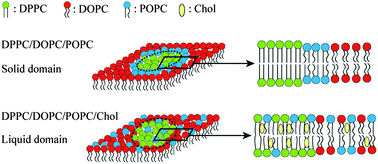Physical properties of the hybrid lipid POPC on micrometer-sized domains in mixed lipid membranes
Abstract
Macro-phase separation in mixed lipid membranes containing the hybrid lipid palmitoyloleoylphosphatidylcholine (POPC) was observed by fluorescent and confocal laser scanning microscopy. In a binary system consisting of the saturated lipid dipalmitoylphosphatidylcholine (DPPC) and the hybrid lipid POPC, the hybrid lipid forms a liquid-disordered (Ld) phase. In a ternary system consisting of this binary system and an unsaturated lipid dioleoylphosphatidylcholine (DOPC), three-phase coexistence is observed. The POPC-rich phase appears around DPPC-rich domains, and the hybrid lipid is expected to behave like a line-active agent (linactant). Finally, phase separation in a four-component system, composed of this ternary system and cholesterol, was examined. Domains with a size that is smaller than 1 μm are found, and domain-induced budding is also observed. To explain small domain formation and domain-induced budding, chain ordering was evaluated based on Laurdan generalized polarization measurements. Our observations revealed that the hybrid lipid acted like a linactant to solid domains and disturbed chain ordering in liquid-ordered (Lo) domains. In both cases, the hybrid lipid reduced line tension at the domain boundary.


 Please wait while we load your content...
Please wait while we load your content...